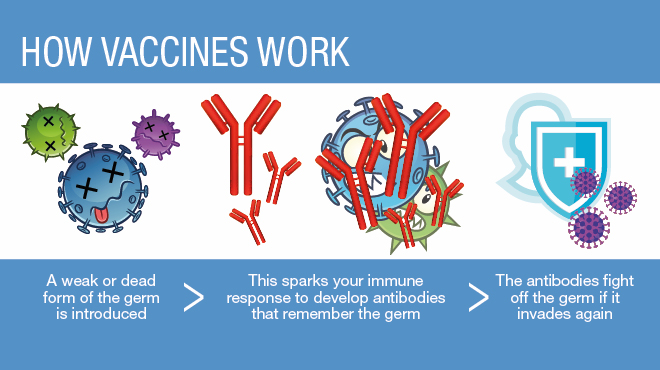One of the major types of treatments is vaccines. You are familiar with having to go to the doctor to get a vaccine or to take your dog or cat to the vet to get one. What are they and how do they work?
- Vaccines help your immune system fight infections faster and more effectively. They are typically made of small amounts of weak or dead germs.
- When you get a vaccine, it sparks your natural immune response, helping your body fight off and remember the germ so it can attack it if the germ ever invades again.
- Vaccines often provide long-lasting immunity to serious diseases without the risk of serious illness. Some vaccines require boosters or provide a shorter period of immunity.
- Vaccines work WITH your adaptive immune system to develop the antibodies that will protect you if you come in contact with that germ (virus or bacteria).

History of Vaccines in the United States: Excerpt from this article.
The smallpox epidemic of 1721 was different than any that came before it. As sickness swept through the city, killing hundreds in a time before modern medical treatment or a robust understanding of infectious disease, an enslaved man known only as Onesimus suggested a potential way to keep people from getting sick. Intrigued by Onesimus’ idea, a brave doctor and an outspoken minister undertook a bold experiment to try to stop smallpox in its tracks.
Smallpox was one of the era’s deadliest afflictions. “Few diseases at this time were as universal or fatal,” notes historian Susan Pryor. The colonists saw its effects not just among their own countrymen, but among the Native Americans to whom they introduced the disease. Smallpox destroyed Native communities that, with no immunity, were unable to fight off the virus.
Mather didn’t trust Onesimus: He wrote about having to watch him carefully due to what he thought was “thievish” behavior, and recorded in his diary that he was “wicked” and “useless.” But in 1716, Onesimus told him something he did believe: That he knew how to prevent smallpox.
Onesimus, who “is a pretty intelligent fellow,” Mather wrote, told him he had had smallpox—and then hadn’t. Onesimus said that he “had undergone an operation, which had given him something of the smallpox and would forever preserve him from it...and whoever had the courage to use it was forever free of the fear of contagion.”
The operation Onesimus referred to consisted of rubbing pus from an infected person into an open wound on the arm. Once the infected material was introduced into the body, the person who underwent the procedure was inoculated against smallpox. It wasn’t a vaccination, which involves exposure to a less dangerous virus to provoke immunity. But it did activate the recipient’s immune response and protected against the disease most of the time.
Mather was fascinated. He verified Onesimus’ story with that of other enslaved people, and learned that the practice had been used in Turkey and China. He became an evangelist for inoculation—also known as variolation—and spread the word throughout Massachusetts and elsewhere in the hopes it would help prevent smallpox.
The SARS-CoV-2 Vaccine:
The new coronavirus vaccines are different than traditional vaccines. This vaccine does not use a weak or dead form of the germ, instead it mimics the protein spike on the pathogen. It is a newer type of vaccine called mRNA vaccines.
Video from PBS on mRNA vaccine.
How the Moderna mRNA vaccine works:
